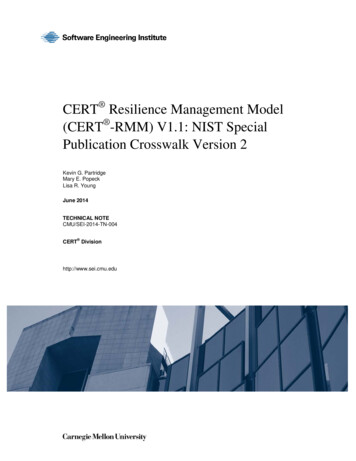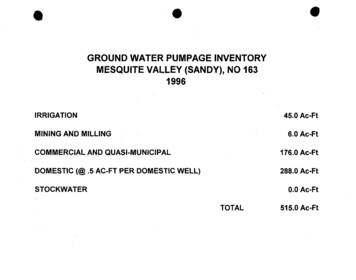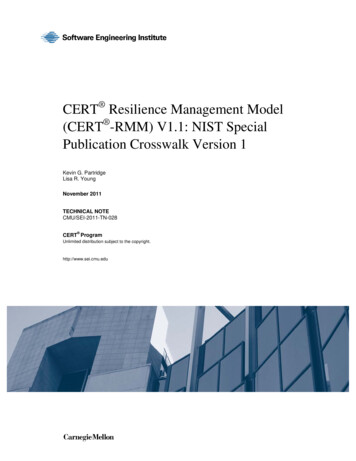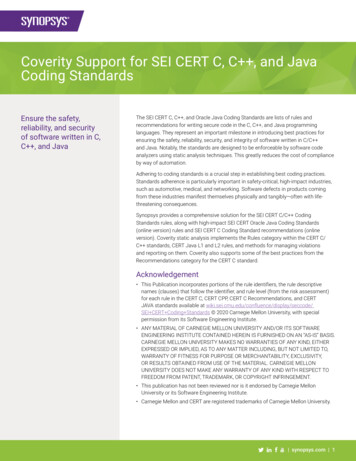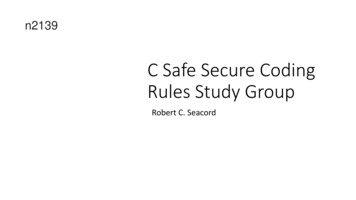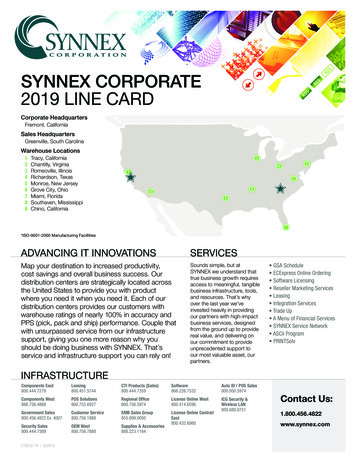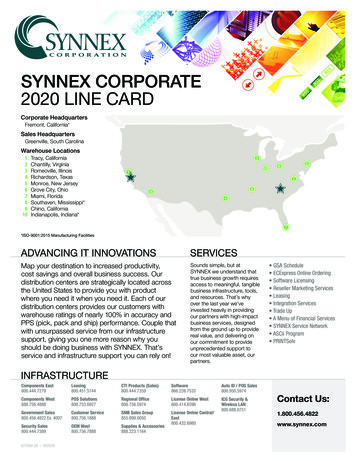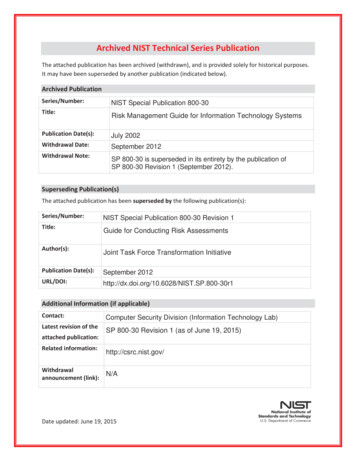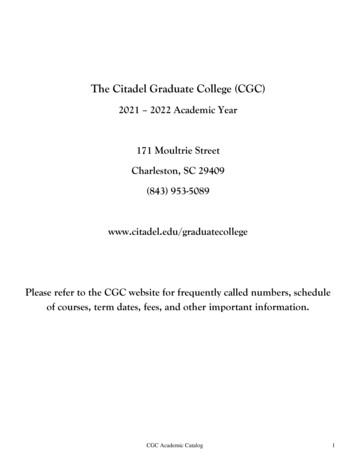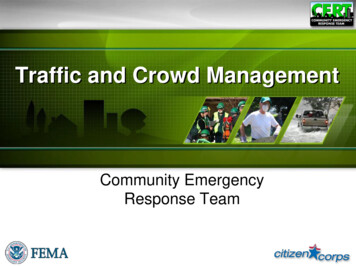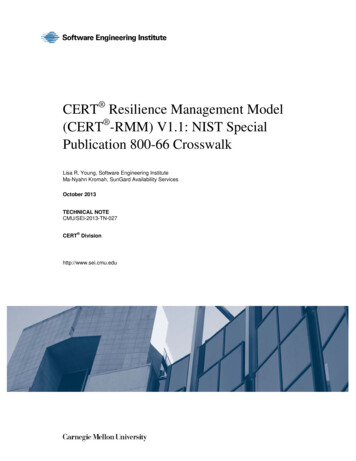
Transcription
CERT Resilience Management Model(CERT -RMM) V1.1: NIST SpecialPublication 800-66 CrosswalkLisa R. Young, Software Engineering InstituteMa-Nyahn Kromah, SunGard Availability ServicesOctober 2013TECHNICAL NOTECMU/SEI-2013-TN-027 CERT Divisionhttp://www.sei.cmu.edu
Copyright 2013 Carnegie Mellon UniversityThis material is based upon work funded and supported by SunGard Availability Services underContract No. FA8721-05-C-0003 with Carnegie Mellon University for the operation of the SoftwareEngineering Institute, a federally funded research and development center sponsored by the UnitedStates Department of Defense.Any opinions, findings and conclusions or recommendations expressed in this material are those of theauthor(s) and do not necessarily reflect the views of SunGard Availability Services or the United StatesDepartment of Defense.This report was prepared for theSEI Administrative AgentAFLCMC/PZM20 Schilling Circle, Bldg 1305, 3rd floorHanscom AFB, MA 01731-2125NO WARRANTY. THIS CARNEGIE MELLON UNIVERSITY AND SOFTWARE ENGINEERINGINSTITUTE MATERIAL IS FURNISHED ON AN “AS-IS” BASIS. CARNEGIE MELLONUNIVERSITY MAKES NO WARRANTIES OF ANY KIND, EITHER EXPRESSED OR IMPLIED,AS TO ANY MATTER INCLUDING, BUT NOT LIMITED TO, WARRANTY OF FITNESS FORPURPOSE OR MERCHANTABILITY, EXCLUSIVITY, OR RESULTS OBTAINED FROM USEOF THE MATERIAL. CARNEGIE MELLON UNIVERSITY DOES NOT MAKE ANYWARRANTY OF ANY KIND WITH RESPECT TO FREEDOM FROM PATENT, TRADEMARK,OR COPYRIGHT INFRINGEMENT.This material has been approved for public release and unlimited distribution except as restrictedbelow.Internal use:* Permission to reproduce this material and to prepare derivative works from this materialfor internal use is granted, provided the copyright and “No Warranty” statements are included with allreproductions and derivative works.External use:* This material may be reproduced in its entirety, without modification, and freelydistributed in written or electronic form without requesting formal permission. Permission is requiredfor any other external and/or commercial use. Requests for permission should be directed to theSoftware Engineering Institute at permission@sei.cmu.edu.* These restrictions do not apply to U.S. government entities.CERT is a registered mark of Carnegie Mellon University.DM-0000666
Table of 1 CERT-RMM Description, Features, and Benefits1.2 CERT-RMM Structure in Relation to NIST Guidelines1122NIST Special Publication 800-662.1 The HIPAA Security Rule2.1.1 HIPAA Security Rule Safeguards4443NIST SP 800-66 to CERT-RMM CrosswalkAdministrative Safeguards4.1. Security Management Process (C.E.R. § 164.308(a)(1))4.2. Assigned Security Responsibility (C.E.R. § 164.308(a)(2))4.3. Workforce Security (C.E.R. § 164.308(a)(3))4.4. Information Access Management (C.E.R. § 164.308(a)(4))4.5. Security Awareness and Training (C.E.R. § 164.308(a)(5))4.6. Security Incident Procedures (C.E.R. § 164.308(a)(6))4.7. Contingency Plan (C.E.R. § 164.308(a)(7))4.8. Evaluation (C.E.R. § 164.308(a)(8))4.9. Business Associate Contracts and Other Arrangements (C.E.R. § 164.308(b)(1))Physical Safeguards4.10. Facility Access Controls (C.E.R. § 164.310(a)(1))4.11. Workstation Use (C.E.R. § 164.310(b))4.12. Workstation Security (C.E.R. § 164.310(c))4.13. Device and Media Controls (C.E.R. § 164.310(d)(1))Technical Safeguards4.14. Access Control (C.E.R. § 164.312(a)(1))4.15. Audit Controls (C.E.R. § 164.312(b))4.16. Integrity (C.E.R. § 164.312(c)(1))4.17. Person or Entity Authentication (C.E.R. § 164.312(d))4.18. Transmission Security (C.E.R. § 52627272930323334CMU/SEI-2013-TN-027 i
CMU/SEI-2013-TN-027 ii
AcknowledgmentsMany individuals have contributed to this report by giving generously of their time and expertise.Their contributions are expressed in the form of ideas, concepts, reviews, edits, andrecommendations. The authors extend thanks and appreciation to Chris Burgher of SunGardAvailability Services for his support, knowledge, and efforts in developing this document;William Gouveia of SunGard Availability Services; Pete Sullivan of InfoSecure Solutions, LLC;Summer Fowler, Technical Manager of the CERT Cyber Resilience Team; and Rich Caralli,Technical Director of the CERT Cyber Enterprise and Workforce Management Directorate. Wealso very much appreciate the fine technical editing and visual enhancement to the document thatPaul Ruggiero of the SEI provided.CMU/SEI-2013-TN-027 iii
CMU/SEI-2013-TN-027 iv
AbstractOrganizations can use the CERT Resilience Management Model (CERT -RMM) V1.1,developed by the CERT Division of Carnegie Mellon University’s Software Engineering Institute,to determine how their current practices can support their level of process maturity in areas ofoperational resilience (business continuity, disaster recovery, management and security planning,and IT operations and service delivery). This technical note is a follow-on to the CERT-RMMCode of Practice Crosswalk, Commercial Version 1.1 (CMU/SEI-2011-TN-012) and connectsCERT-RMM process areas to NIST Special Publication 800-66 Revision 1: An IntroductoryResource Guide for Implementing the Health Insurance Portability and Accountability Act(HIPAA) Security Rule.CMU/SEI-2013-TN-027 v
CMU/SEI-2013-TN-027 vi
1 IntroductionOrganizations can use the CERT Resilience Management Model (CERT -RMM) V1.1,developed by the CERT Division of Carnegie Mellon University’s Software Engineering Institute,to determine how their current practices can support their level of process maturity in areas ofoperational resilience (business continuity, disaster recovery, management and security planning,and IT operations and service delivery). This technical note is a follow-on to the CERT-RMMCode of Practice Crosswalk, Commercial Version 1.1 (CMU/SEI-2011-TN-012) [Partridge2011a] and connects CERT-RMM process areas to NIST Special Publication 800-66 Revision 1:An Introductory Resource Guide for Implementing the Health Insurance Portability andAccountability Act (HIPAA) Security Rule [Scholl 2008].This crosswalk helps to achieve a primary goal of CERT-RMM, which is to allow users tocontinue to use preferred standards and codes of practice at a strategic level while maturingmanagement of operational resilience at a process level. This document provides a reference forusers of CERT-RMM to determine how their current deployment of HIPAA practices supportstheir desired level of process maturity and improvement.The key activities, and their descriptions, of the CERT-RMM process areas align with theguidance within NIST SP 800-66. The crosswalk in this technical note does not reflect anydiscontinuities at this level between the two. It connects NIST SP 800-66 key activities andCERT-RMM goals, practices, and general goals according to their shared subject matter andfocus.1.1 CERT-RMM Description, Features, and BenefitsCERT-RMM V1.1 is a capability maturity model for managing operational resilience. It has twoprimary objectives: Establish the convergence of operational risk and resilience management activities (securityplanning and management, business continuity, IT operations, and service delivery) into asingle model. Apply a process improvement approach to operational resilience management by defining andapplying a capability scale expressed in increasing levels of process maturity.CERT-RMM has the following features and benefits:provides a process definition, expressed in 26 process areas across four categories: enterprisemanagement, engineering, operations, and process management focuses on the resilience of four essential operational assets: people, information,technology, and facilities includes processes and practices that define a scale of four capability levels for each processarea: incomplete, performed, managed, and defined CERT is a registered mark owned by Carnegie Mellon University.CMU/SEI-2013-TN-027 1
serves as a meta-model that includes references to common codes of practice such as theNIST Special Publications 800 series, the International Organization for Standards (ISO) andInternational Electrotechnical Commission (IEC) 27000 series, COBIT, the British StandardsInstitution’s BS 25999, and ISO 24762 includes quantitative process measurements that can be used to ensure operational resilienceprocesses are performing as intended facilitates an objective measurement of capability levels via a structured and repeatableappraisal methodology extends the process improvement and maturity pedigree of Capability Maturity ModelIntegration (CMMI ) to assurance, security, and service continuity activitiesA copy of the current version of CERT-RMM can be obtained athttp://www.cert.org/resilience/rmm.html.1.2 CERT-RMM Structure in Relation to NIST GuidelinesCERT-RMM is organized by several key components. The process area is the major structuralelement in the model. Each process area has a series of descriptive components. CERT-RMM hastwo types of practices: specific practices and subpractices. The subpractices are the level at whichCERT-RMM connects with specific guidance in codes of practice or standards. To make use ofand gain key benefits from the crosswalk presented in this document, it is important to understandthe distinctions among these types of practices and subpractices in CERT-RMM and theirconnection to the HIPAA Security Rule.Process AreaCERT-RMM has four categories—enterprise management, engineering, operations, and processmanagement—which together comprise 26 process areas. Each process area describes a functionalarea of competency. In aggregate, these 26 process areas define the operational resiliencemanagement system. Process areas comprise goals, each achieved through specific practices,which are themselves broken down into subpractices.Process Area: GoalsEach process area has a set of goals. Goals are required elements of the process area, and theydefine its target accomplishments. An example of a goal from the Risk Management process areais “RISK:SG1 Prepare for Risk Management.”Process Area: Specific PracticesEach process area goal has its own specific practices. Specific practices establish a process area’sbase practices, reflect its body of knowledge, and describe what must be done to accomplish aprocess area goal. An example of a specific practice from the Risk Management process area is“RISK:SG1.SP1 Determine Risk Sources and Categories,” which supports the goal “RISK:SG1Prepare for Risk Management.”CMU/SEI-2013-TN-027 2
Process Area: SubpracticesSpecific practices break down into subpractices. Subpractices are informative elements associatedwith each specific practice. These subpractices can often be related to specific process workproducts. Where specific practices focus on what must be done, subpractices focus on how it mustbe done. While not overly prescriptive or detailed, subpractices help the user determine how tosatisfy the specific practices and achieve the goals of the process area. Each organization willhave its own subpractices, either organically or by acquiring them from a code of practice.Subpractices can be linked to the HIPAA Security Rule found in NIST SP 800-66.Generic GoalsGeneric goals are relevant to all process areas but are defined within and customized to individualprocess areas. Their degree of achievement indicates an organization’s integration of a process’slevel into its fundamental values (policies, standards, code of conduct, strategic plans, values,vision, etc.). Achievement of a generic goal is an indicator that the associated practices have beenimplemented across the process area. These goals ensure that the process area will be effective,repeatable, and lasting.This crosswalk is not intended to map the NIST SP 800-66 HIPAA Security Privacy Rule acrossall generic goals or assert that a special publication helps an organization achieve any particularcapability or maturity rating.CMU/SEI-2013-TN-027 3
2 NIST Special Publication 800-66Special Publication 800-66 (SP 800-66) Revision 1: An Introductory Resource Guide forImplementing the Health Insurance Portability and Accountability Act (HIPAA) Security Rule is apublication from the National Institute of Standards and Technology for United States federalgovernment agencies that may be subject to the Health Insurance Portability and AccountabilityAct of 1996 (HIPAA). HIPAA was enacted with two major goals: Title I of HIPAA protectshealth insurance coverage for workers and their families when they lose or change jobs, and TitleII of HIPAA requires the establishment of national standards for electronic health caretransactions and the security of patient data. Title II of HIPAA contains two important provisionsfor the protection of patient data, the Privacy Rule and the Security Rule.NIST SP 800-66 focuses exclusively on the implementation of the HIPAA Security Rule. NISTSP 800-66 does not cover other elements of HIPAA (i.e., the HIPAA Privacy Rule). Additionally,NIST SP 800-66 does not cover the extensions to the HIPAA Security Rule by the HealthInformation Technology for Economic and Clinical Health Act (HITECH Act). The HITECH Actis part of the American Recovery and Reinvestment Act of 2009.This crosswalk between CERT-RMM and NIST SP 800-66 covers only the AdministrativeSafeguards, Physical Safeguards, and Technical Safeguards of the HIPAA Security Rule. It doesnot cover the organizational components or the Policies and Procedures and DocumentationRequirements of the HIPAA Security Rule.2.1 The HIPAA Security RuleThe HIPAA Security Rule protects all individually identifiable health information a coveredentity creates, receives, maintains, or transmits in electronic form. This information is defined asElectronic Protected Health Information (e-PHI). The Security Rule covers only protected healthinformation that is electronic in nature, not information that is transmitted orally or in writtenform.The Security Rule requires maintenance of reasonable and appropriate administrative, technical,and physical safeguards for protecting e-PHI. Organizations handling e-PHI must ensure the confidentiality, integrity, and availability of all e-PHI created, received, maintainedor transmitted identify and protect against reasonably anticipated threats to the security or integrity ofinformation protect against reasonably anticipated, impermissible uses or disclosures ensure compliance by the workforce2.1.1HIPAA Security Rule SafeguardsThe HIPAA Security Rule defines safeguards in several areas: Administrative Safeguards—“Administrative actions and policies, and procedures to managethe selection, development, implementation, and maintenance of security measures to protectCMU/SEI-2013-TN-027 4
electronic protected health information and to manage the conduct of the covered entity’sworkforce in relation to the protection of that information.” Physical Safeguards—“Physical measures, policies, and procedures to protect a coveredentity’s electronic information systems and related buildings and equipment, from natural andenvironmental hazards, and unauthorized intrusion.” Technical Safeguards—“The technology and the policy and procedures for its use that protectelectronic protected health information and control access to it.”NIST SP 800-66 describes the following Administrative, Physical, and Technical Safeguards:Administrative Safeguards Security Management Process Assigned Security Responsibility Workforce Security Information Access Management Security Awareness and Training Security Incident Procedures Contingency Plan Evaluation Business Associate Contracts and Other ArrangementsPhysical Safeguards Facility Access Controls Workstation Use Workstation Security Device and Media ControlsTechnical Safeguards Access Control Audit Controls Integrity Person or Entity Authentication Transmission SecurityCMU/SEI-2013-TN-027 5
3 NIST SP 800-66 to CERT-RMM CrosswalkThis crosswalk describes the mapping between CERT-RMM and NIST SP 800-66. All of theAdministrative, Physical, and Technical Safeguards described in NIST SP 800-66 are mapped tospecific practices within a CERT-RMM process area. This crosswalk aligns the tactical practicessuggested in NIST SP 800-66 to the CERT-RMM process areas and specific practices thatdescribe management of operational resilience at a process level.This technical note shows the areas of connection between CERT-RMM process areas and theguidance in NIST SP 800-66. The CERT-RMM provides a reference model that allowsorganizations to make sense of their practices in a process context to improve processes andeffectiveness. This crosswalk can help organizations align NIST SP 800-66 practices to CERTRMM process improvement goals, with the overall goal of using CERT-RMM to managecompliance with the HIPAA Security Rule.CMU/SEI-2013-TN-027 6
NIST SP 800-66 Key Activities and DescriptionCERT-RMM MappingAdministrative Safeguards4.1. Security Management Process (C.E.R. § 164.308(a)(1))HIPAA Standard: Implement policies and procedures to prevent, detect, contain, and correct security violations.1. Identify Relevant Information Systems ADM:SG1.SP1 Inventory Assets Identify all information systems that house e-PHI. ADM:SG1.SP3 Identify Asset Owner & Custodians Include all hardware and software that are used to collect, store, process, or transmit e-PHI. KIM:SG1.SP1 Prioritize Information Assets Analyze business functions and verify ownership and control of information system elements as necessary.2. Conduct Risk AssessmentImplementation Specification (Required) Conduct an accurate and thorough assessment of the potential risks and vulnerabilities to the confidentiality,integrity, and availability of e-PHI held by the covered entity.3. Implement a Risk Management ProgramImplementation Specification (Required) Implement security measures sufficient to reduce risks and vulnerabilities to a reasonable and appropriatelevel to comply with §164.306(a). RISK:SG4.SP1 Evaluate Risk RISK:SG4.SP2 Categorize and Prioritize Risk RISK:GG2.GP4 Assign Responsibility RISK:SG5.SP2 Implement Risk Strategies RISK:SG5.SP1 Develop Risk Mitigation Pans RISK:SG6.SP1 Review and Adjust Strategies to ProtectAssets and Services RISK:SG6.SP2 Review and Adjust Strategies to SustainServices4. Acquire IT Systems and Services Although the HIPAA Security Rule does not require purchasing any particular technology, additionalhardware, software, or services may be needed to adequately protect information. Considerations for theirselection should include the following: ApplicabilityTechnology Assets TM:SG2.SP2 Establish and Implement Controlsof the IT solution to the intended environment; Thesensitivity of the data; Theorganization’s security policies, procedures, and standards; and Other TM:SG2.SP1 Assign Resilience Requirements torequirements such as resources available for operation, maintenance, and training.CMU/SEI-2013-TN-027 7
NIST SP 800-66 Key Activities and DescriptionCERT-RMM MappingAdministrative Safeguards4.1. Security Management Process (C.E.R. § 164.308(a)(1))HIPAA Standard: Implement policies and procedures to prevent, detect, contain, and correct security violations.(continued)5. Create and Deploy Policies and Procedures Implement the decisions concerning the management, operational, and technical controls selected to mitigateidentified risks. Create policies that clearly establish roles and responsibilities and assign ultimate responsibility for theimplementation of each control to particular individuals or offices. RISK:SG5.SP1 Develop Risk Mitigation Plan GG2.GP1 Establish Process Governance GG2.GP4 Assign Responsibility GG2.GP7 Identify and Involve Relevant Stakeholders Create procedures to be followed to accomplish particular security-related tasks.6. Develop and Implement a Sanction PolicyImplementation Specification (Required) HRM:SG3.SP4 Establish Disciplinary Process Apply appropriate sanctions against workforce members who fail to comply with the security policies andprocedures of the covered entity. Develop policies and procedures for imposing appropriate sanctions (e.g., reprimand, termination) fornoncompliance with the organization’s security policies. Implement sanction policy as cases arise.7. Develop and Deploy the Information System Activity Review ProcessImplementation Specification (Required) Implement procedures to regularly review records of information system activity, such as audit logs, accessreports, and security incident tracking reports.8. Develop Appropriate Standard Operating Procedures Determine the types of audit trail data and monitoring procedures that will be needed to derive exceptionreports. TM:SG2.SP2 Establish and Implement Controls IMC:SG2.SP2 Log and Track Events EF:SG4.SP2 Perform Resilience Oversight MON:SG2.SP2 Establish Collection Standard andGuidelines MON:SG1.SP3 Establish Monitoring Requirements MON:SG1.SP4 Analyze and Prioritize MonitoringRequirements9. Implement the Information System Activity Review and Audit Process Activate the necessary review process. Begin auditing and logging activity. MON:SG1.SP3 Establish Monitoring Requirements MON:SG2.SP2 Establish Collection Standard andGuidelines COMP:SG4.SP1 Evaluate Compliance ActivitiesCMU/SEI-2013-TN-027 8
NIST SP 800-66 Key Activities and DescriptionCERT-RMM MappingAdministrative Safeguards4.2. Assigned Security Responsibility (C.E.R. § 164.308(a)(2))HIPAA Standard: Identify the security official who is responsible for the development and implementation of the policies and procedures required by this subpart for the entity.1. Select a Security Official To Be Assigned Responsibility for HIPAA Security Identify the individual who has final responsibility for security. Select an individual who is able to assess effective security and to serve as the point of contact for securitypolicy, implementation, and monitoring. EF:SG4.SP1 Establish Resilience as a GovernanceFocus Area EF:GG2.GP2 Plan the Process EF:GG2.G4 Assign Responsibility IMC:GG2.GP2 Plan the Process IMC:GG2.GP4 Assign Responsibility2. Assign and Document the Individual’s Responsibility EF & IMC:GG2.GP2 Plan the Process Document the assignment to one individual’s responsibilities in a job description. EF & IMC:GG2.G4 Assign Responsibility Communicate this assigned role to the entire organization. HRM:SG2.SP2 Establish Terms and Conditions ofEmployment PM:SG1.SP1 Identify Vital Staff GG2 & GG4NIST SP 800-66 Key Activities and DescriptionCERT-RMM MappingAdministrative Safeguards4.3. Workforce Security (C.E.R. § 164.308(a)(3))HIPAA Standard: Implement policies and procedures to ensure that all members of its workforce have appropriate access to electronic protected health information, as providedunder paragraph (a)(4) of this section, and to prevent those workforce members who do not have access under paragraph (a)(4) of this section from obtaining access toelectronic protected health information.1. Implement Procedures for Authorization and/or SupervisionImplementation Specification (Addressable) AM:SG1 Manage and Control Access (SP1-SP4) ID:SG2.SP2 Periodically Review and Maintain Identities Implement procedures for the authorization and/or supervision of workforce members who work with e-PHI orin locations where it might be accessed.CMU/SEI-2013-TN-027 9
NIST SP 800-66 Key Activities and DescriptionCERT-RMM MappingAdministrative Safeguards4.3. Workforce Security (C.E.R. § 164.308(a)(3))HIPAA Standard: Implement policies and procedures to ensure that all members of its workforce have appropriate access to electronic protected health information, as providedunder paragraph (a)(4) of this section, and to prevent those workforce members who do not have access under paragraph (a)(4) of this section from obtaining access toelectronic protected health information.(continued)2. Establish Clear Job Descriptions and Responsibilities Define roles and responsibilities for all job functions. HRM:SG2.SP2 Establish Terms and Conditions forEmployment Assign appropriate levels of security oversight, training, and access. ID:SG1.SP3 Assign Roles and Identities Identify in writing who has the business need—and who has been granted permission—to view, alter,retrieve, and store e-PHI, and at what times, under what circumstances, and for what purposes. AM:SG1.SP1 Enable Access3. Establish Criteria and Procedures for Hiring and Assigning Tasks Ensure that staff members have the necessary knowledge, skills, and abilities to fulfill particular roles, e.g.,positions involving access to and use of sensitive information. Ensure that these requirements are included as part of the personnel hiring process. HRM:SG4.SP2 Manage Access to Assets HRM:SG2.SP2 Establish Terms and Conditions forEmployment HRM:SG3.SP1 Establish Resilience as a JobResponsibility AM:SG1.SP3 Periodically Review and Maintain AccessPrivileges AM:SG1.SP4 Correct Inconsistencies4. Establish a Workforce Clearance ProcedureImplementation Specification (Addressable) Implement procedures to determine that the access of a workforce member to e-PHI is appropriate. Implement appropriate screening of persons who will have access to e-PHI. Implement a procedure for obtaining clearance from appropriate offices or individuals where access isprovided or terminated. HRM:SG2.SP1 Verify Suitability of Candidate Staff HRM:SG4.SP2 Manage Access to Assets HRM:SG4.SP3 Manage Involuntary Terminations AM:SG1.SP1 Enable Access AM:SG1.SP3 Periodically Review and Maintain AccessPrivileges AM:SG1.SP4 Correct InconsistenciesCMU/SEI-2013-TN-027 10
NIST SP 800-66 Key Activities and DescriptionCERT-RMM MappingAdministrative Safeguards4.3. Workforce Security (C.E.R. § 164.308(a)(3))HIPAA Standard: Implement policies and procedures to ensure that all members of its workforce have appropriate access to electronic protected health information, as providedunder paragraph (a)(4) of this section, and to prevent those workforce members who do not have access under paragraph (a)(4) of this section from obtaining access toelectronic protected health information.(continued)5. Establish Termination ProceduresImplementation Specification (Addressable) Implement procedures for terminating access to e-PHI when the employment of a workforce member ends oras required by determinations made as specified in §164.308(a)(3)(ii)(B). HRM:SG4.SP1 Manage Impact of Position Changes HRM:SG4.SP2 Manage Access to Assets HRM:SG4.SP3 Manage Involuntary Termination Develop a standard set of procedures that should be followed to recover access control devices(Identification [ID] badges, keys, access cards, etc.) when employment ends. Deactivate computer access accounts (e.g., disable user IDs and passwords). See the Access ControlsStandard.NIST SP 800-66 Key Activities and DescriptionCERT-RMM MappingAdministrative Safeguards4.4. Information Access Management (C.E.R. § 164.308(a)(4))HIPAA Standard: Implement policies and procedures to prevent, detect, contain, and correct security violations.1. Isolate Healthcare Clearinghouse FunctionsImplementation Specification (Required) If a healthcare clearinghouse is part of a larger organization, the clearinghouse must implement policies andprocedures that protect the e-PHI of the clearinghouse from unauthorized access by the larger organization. Determine if a component of the covered entity constitutes a healthcare clearinghouse under the HIPAASecurity Rule. KIM:SG4.SP2 Control Access to Information Assets EXD:SG2.SP2 Mitigate Risk Due to ExternalDependencies ADM:SG1.SP3 Establish Ownership and Custodianship ADM:SG2.SP2 Analyze Asset-Service Dependencies If no clearinghouse functions exist, document this finding. If a clearinghouse exists within the organization,implement procedures for access consistent with the HIPAA Privacy Rule.CMU/SEI-2013-TN-027 11
NIST SP 800-66 Key Activities and DescriptionCERT-RMM MappingAdministrative Safeguards4.4. Information Access Management (C.E.R. § 164.308(a)(4))HIPAA Standard: Implement policies and procedures to prevent, detect, contain, and correct security violations.(continued)2. Implement Policies and Procedures for Authorizing AccessImplementation Specification (Addressable) Implement policies and procedures for granting access to e-PHI, for example, through access to aworkstation, transaction, program, process, or other mechanism. AM:SG1 Manage and Control Access (SP1-SP4) TM:SG4.SP1 Control Access to Technology Assets Decide how access will be granted to workforce members within the organization. Select the basis for restricting access. Select an access control method (e.g., identity-based, role-based, or other reasonable and appropriatemeans of access.) Determine if direct access to e-PHI will ever be appropriate for individuals external to the organization (e.g.,business partners or patients seeking access to their own e-PHI).3. Implement Policies and Procedures for Access Establishment and ModificationImplementation Specification (Addressable) Implement policies and procedures that, based upon the entity’s access authorization policies, establish,document, review, and modify a user’s right of access to a workstation, transaction, program, or process. KIM:SG4.SP2 Control Access to Information Assets AM:SG1 Manage and Control Access (SP1-SP4) AM:GG2.GP1 Establish Process Governance Establish standards for granting access. Provide formal authorization from the appropriate authority before granting access to sensitive information.4. Evaluate Existing Security Measures Related to Access Controls Evaluate the security features of access controls already in place, or those of any planned forimplementation, as appropriate. Determine if these security features involve alignment with other existing management, oper
1.1 CERT-RMM Description, Features, and Benefits 1 1.2 CERT-RMM Structure in Relation to NIST Guidelines 2 2 NIST Special Publication 800-66 4 2.1 The HIPAA Security Rule 4 2.1.1 HIPAA Security Rule Safeguards 4 3 NIST SP 800-66 to CERT-RMM Crosswalk 6 Administrative Safeguards 7 4.1.
